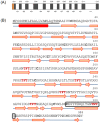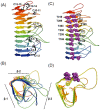New Cysteine-Rich Ice-Binding Protein Secreted from Antarctic Microalga, Chloromonas sp
- PMID: 27097164
- PMCID: PMC4838330
- DOI: 10.1371/journal.pone.0154056
New Cysteine-Rich Ice-Binding Protein Secreted from Antarctic Microalga, Chloromonas sp
Abstract
Many microorganisms in Antarctica survive in the cold environment there by producing ice-binding proteins (IBPs) to control the growth of ice around them. An IBP from the Antarctic freshwater microalga, Chloromonas sp., was identified and characterized. The length of the Chloromonas sp. IBP (ChloroIBP) gene was 3.2 kb with 12 exons, and the molecular weight of the protein deduced from the ChloroIBP cDNA was 34.0 kDa. Expression of the ChloroIBP gene was up- and down-regulated by freezing and warming conditions, respectively. Western blot analysis revealed that native ChloroIBP was secreted into the culture medium. This protein has fifteen cysteines and is extensively disulfide bonded as shown by in-gel mobility shifts between oxidizing and reducing conditions. The open-reading frame of ChloroIBP was cloned and over-expressed in Escherichia coli to investigate the IBP's biochemical characteristics. Recombinant ChloroIBP produced as a fusion protein with thioredoxin was purified by affinity chromatography and formed single ice crystals of a dendritic shape with a thermal hysteresis activity of 0.4±0.02°C at a concentration of 5 mg/ml. In silico structural modeling indicated that the three-dimensional structure of ChloroIBP was that of a right-handed β-helix. Site-directed mutagenesis of ChloroIBP showed that a conserved region of six parallel T-X-T motifs on the β-2 face was the ice-binding region, as predicted from the model. In addition to disulfide bonding, hydrophobic interactions between inward-pointing residues on the β-1 and β-2 faces, in the region of ice-binding motifs, were crucial to maintaining the structural conformation of ice-binding site and the ice-binding activity of ChloroIBP.
Conflict of interest statement
Figures













Similar articles
-
Isolation and characterization of antifreeze proteins from the antarctic marine microalga Pyramimonas gelidicola.Mar Biotechnol (NY). 2014 Oct;16(5):502-12. doi: 10.1007/s10126-014-9567-y. Epub 2014 Mar 8. Mar Biotechnol (NY). 2014. PMID: 24609978
-
Cryo-protective effect of an ice-binding protein derived from Antarctic bacteria.FEBS J. 2017 Jan;284(1):163-177. doi: 10.1111/febs.13965. Epub 2016 Dec 26. FEBS J. 2017. PMID: 27860412
-
Structure-function relationships in spruce budworm antifreeze protein revealed by isoform diversity.Eur J Biochem. 2000 Oct;267(19):6082-8. doi: 10.1046/j.1432-1327.2000.01694.x. Eur J Biochem. 2000. PMID: 10998070
-
Ice-binding proteins and the 'domain of unknown function' 3494 family.FEBS J. 2019 Mar;286(5):855-873. doi: 10.1111/febs.14764. Epub 2019 Feb 9. FEBS J. 2019. PMID: 30680879 Review.
-
Molecular recognition and binding of thermal hysteresis proteins to ice.J Mol Recognit. 2000 Mar-Apr;13(2):101-13. doi: 10.1002/(SICI)1099-1352(200003/04)13:2<101::AID-JMR493>3.0.CO;2-9. J Mol Recognit. 2000. PMID: 10822254 Review.
Cited by
-
Diatoms and Their Microbiomes in Complex and Changing Polar Oceans.Front Microbiol. 2022 Mar 25;13:786764. doi: 10.3389/fmicb.2022.786764. eCollection 2022. Front Microbiol. 2022. PMID: 35401494 Free PMC article. Review.
-
Marine Antifreeze Proteins: Structure, Function, and Application to Cryopreservation as a Potential Cryoprotectant.Mar Drugs. 2017 Jan 27;15(2):27. doi: 10.3390/md15020027. Mar Drugs. 2017. PMID: 28134801 Free PMC article. Review.
-
Gypsum endolithic phototrophs under moderate climate (Southern Sicily): their diversity and pigment composition.Front Microbiol. 2023 Jul 6;14:1175066. doi: 10.3389/fmicb.2023.1175066. eCollection 2023. Front Microbiol. 2023. PMID: 37485515 Free PMC article.
-
Multiple ice-binding proteins of probable prokaryotic origin in an Antarctic lake alga, Chlamydomonas sp. ICE-MDV (Chlorophyceae).J Phycol. 2017 Aug;53(4):848-854. doi: 10.1111/jpy.12550. Epub 2017 Jul 5. J Phycol. 2017. PMID: 28543018 Free PMC article.
-
Identification of novel antifreeze peptides from yak skin gelatin ultrasound-assisted enzymatic hydrolysate.Ultrason Sonochem. 2024 Dec;111:107102. doi: 10.1016/j.ultsonch.2024.107102. Epub 2024 Oct 16. Ultrason Sonochem. 2024. PMID: 39433007 Free PMC article.
References
-
- Priddle J, Hawes I, Ellis-Evans JC. Antarctic aquatic ecosystems as habitats for phytoplankton. Biol Rev. 1986; 61(3):199–238.
-
- Ehn JK, Mundy CJ. Assessment of light absorption within highly scattering bottom sea ice from under-ice light measurements: Implications for Arctic ice algae primary production. Limnol Oceanogr. 2013; 58(3):893–902.
-
- Thomas DN, Dieckmann GS. Antarctic sea ice-a habitat for extremophiles. Science. 2002; 295(5555):641–4. - PubMed
-
- Mock T, Thomas DN. Recent advances in sea-ice microbiology. Environ Microbiol. 2005; 7(5):605–19. - PubMed
-
- Eicken H, Bock C, Wittig R, Miller H, Poertner HO. Magnetic resonance imaging of sea-ice pore fluids: methods and thermal evolution of pore microstructure. Cold Reg Sci Technol. 2000; 31(3):207–25.
Publication types
MeSH terms
Substances
Associated data
- Actions
Grants and funding
LinkOut - more resources
Full Text Sources
Other Literature Sources

